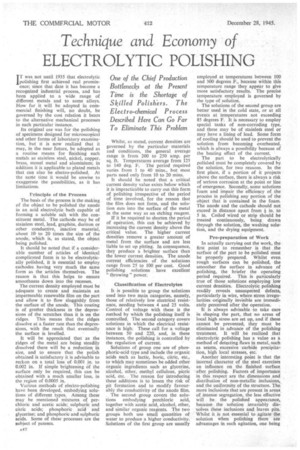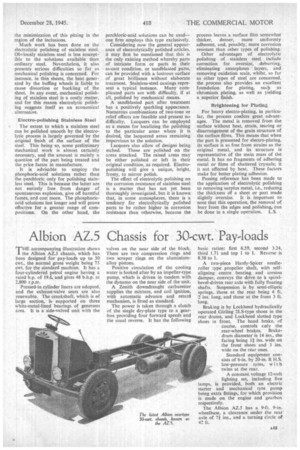Technique and Economy of
Page 44

Page 47

If you've noticed an error in this article please click here to report it so we can fix it.
ELECTROLYTIC POLISHING
One of the Chief Production Bottlenecks at the Present Time is the Shortage of Skilled Polishers. The Elec it o-chemical Process Described Here Can Go Far To Eliminate This Problem
IT was not until 1935 that electrolytic polishing first achieved real prominence; since that date it has become a recognized industrial process, and has been applied to a wide range of different metals and to some alloys. How far it will be adopted in commercial finishing will, no doubt, be governed by the cost relation it bears to the alternative mechanical processes in each particular instance.
Its original use was for the polishing of specimens designed for microscopical and other forms of laboratory examination, but it is now realized that it may,. in the near future, be adopted as a routine means for finishing such metals as stainless steel, nickel, copper, brass, mood metal and aluminium; in addition it is applicable to plated metals that can also be electro-polished. At the same time it would be unwise to exaggerate the possibilities, as it has Principle of the Process The basis of the process is the making of the object to be polished the anode in an acid electrolytic bath capable of forming a soluble salt with the constituent metal. The cathode may be of stainless steel, lead, graphite, duriron or other conductive, inactive material, about 10 to 20 times the size of the anode, which is, as stated, the object being polished.
It should be noted that if a considerable number of articles of identical complicated form is to be electrolytically polished, it is essential to employ cathodes having very much the same form as the articles themselves. The reason is that this helps to ensure smoothness down into the recesses.
The current density employed must he adequate to create and maintain an impermeable renewable film on the part and allow it to flow sluggishly from the surface of the anode. This coating is of greater thickness in the depressions of the scratches than it is on the ridges. This means that the ridges dissolve at a faster rate than the depressions, with the result that eventually the surface is levelled.
It will be appreciated that as the ridges of the metal are being steadily dissolved there will be a reduction in size, and to ensure that the polish obtained is satisfactory it is advisable to reckon on a total loss of 0.001 in. to 0.002 in. If simple brightening of the surface only be required, this can be obtained with a much smaller loss, in the region of 0.0005 in.
Various methods of electro-polishing have been developed, embodying solutions of different types. Among these may be mentioned mixtures of perchloric and acetic acids; sulphuric and citric acids; phosphoric acid and glycerine; and phosphoric and sulphuric acids. Some of these processes are the subject of patents. Whilst, as stated, current densities are governed by the particular • materials and conditions, the general average range is from 200 to 250 amp. per sq. ft. Temperatures average from 125 to 140 deg. F. " The period required varies from 1 to 40 mins., but most parts need only from 10 to 20 mins.
It should be noted that a critical current density value exists below which it is impracticable to carry out this form of polishing irrespective of the period of time involved, for the reason that the film does not form, and the solu tion eats into the surface of the metal in the same way as an etching reagent.
If it be required to shorten the period of operation, this can be achieved by increasing the current density above the critical value. The higher current densities remove a greater amount of metal from the surface and are less liable to set up pitting. In consequence, they produce a brighter surface than the lower current densities. The anode current efficiencies , of the solutions range from 25 to 100 per cent. Good polishing solutions have excellent " throwing " power.
Classification of Electrolytes It is possible to group the solutions used into two main categories, namely, those of relatively low electrical resistance, needing between 4 and 25 volts. Control of voltage with these is the method by which the polishing itself is controlled. The second category covers solutions in which the electrical resistance is high: These call for a voltage between 50 and 220, and, in these instances, the polishing is controlled by the regulation of current.
Solutions of group one are of phosphoric-acid type and include the organic acids such as lactic, boric, citric, etc., to which may sometimes be added other Organic ingredients such as glycerine, alcohol, ether, methyl cellulose, picric acid, etc. The reason for introducing these additions is to lessen the risk of pit formation and to modify favourably the conductivity of the anode film.
The second group covers the solutions embodying perchloric acid, together with acetic acid, alcohol, ether, and similar organic reagents. The two groups both use small quantities of water to produce a higher conductivity. Solutions of the first group are usually employed at temperatures between 100 and 300 degrees F., because within this temperature range they appear to give more satisfactory results. The precise temperature employed is governed by the type of solution.
The solutions of the second group are better used in the cold state, or at all events at temperatures not exceeding 85 degrees F. It is necessary to employ special tanks of non-corroding type, and these may be of stainless steel or may have a lining of lead. Some form of cooling should be used to prevent the solution from becoming overheated, which is always a possibility because of the heating effect of the current.
The part to be electrolytically polished must be completely covered by the solution, for two reasons. In the first place, if a portion of it projects above the surface, there is always a risk of serious corrosion at the point or line of emergence. Secondly, some solutions foam and impair the efficiency of the process in polishing any portion of the object that is contained in the foam. The anode and the cathode should not exceed in distance apart from in. to 5 in. Coiled wired or strip should be treated continuously, being drawn thrpugh the solution, the washing solution, and the drying equipment.
Pre-preparation of Work
In actually carrying out the work, the first point to remember is that the surface of the part to be polished must be properly prepared. Whilst even rough surfaces can be polished, the smoother the surface in advance of polishing, the briefer the operating period required. This is particularly true of those solutions employing low current densities. Electrolytic polishing readily reveals unsuspected defects, particularly in wire, where stress irregularities originally invisible are immediately perceived after the operation.
It is always advisable to take care in shaping the part, that no areas of local high stress are set up, and, if these cannot be prevented, they must be eliminated in advance of the polishing treatment. It will be realized that electrolytic polishing has a value as a method of detecting flaws in metal, such as seams, excessive carbide precipitation, high local stresses, etc.
Another interesting point is that the internal character of the steel exercises an influence on the finished surface. after polishing. Factors of importance in this respect are the dimensions and distribution of non-metallic inclusions, and the uniformity, of the structure. The more inclusions that are present in areas of intense segregation, the less effective will be the polished appearance, because the solution invariably dis-, solves these inclusions and leaves pits. Whilst it is not essential to agitate the solution when polishing there are advantages in such agitation, one being
the minimization of this pitting in the region of the inclusions.
Much work has been done on the electrolytic polishing of stainless steel. Obviously stainless steel is less susceptible to the solutions available than ordinary steel. Nevertheless, it also presents serious difficulties so far as mechanical polishing is concerned. For instance, in thin sheets, the heat generated by the buffing wheels is liable to cause distortion or buckling of the sheet. In any event, mechanical polishing of stainless steel is a costly matter, and for this reason electrolytic polishing suggests itself as an economical alternative.
Electro-polishing Stainless Steel The extent to which a stainless steel can be polished smooth by the electrolytic process is largely governed by the original finish of the surface of the steel. This being so, some preliminary mechanical work is almost certainly necessary, and the amount is mainly a question of the part being treated and the price factot in manufacture.
It is advisable to employ the phosphoric-acid solutions rather than the perchloric only for polishing stainless steel. This is because the tatter are not entirely free from danger of spontaneous explosion, give off harmful fumes, and cost more. The phosphoricacid solutions last longer and will prove effective for a greater range of compositions. On the other hand, the perchloric-acid solutions can be used— one firm employs this type exclusively.
Considering now the general appearance of electrolytically polished articles, it may first be mentioned that this is the only existing method whereby parts of intricate form or parts in their as-cast condition, or sandblasted parts, can be provided with a lustrous surface of great brilliance without elaborate treatment. Stainless-steel castings represent a typical instance. Many complicated parts are with difficulty, if at all, polished by mechanical means.
A sandblasted part after treatment has a positively sparkling appearance. Numerous combinations of two-tone or relief effects are feasible and present no difficulty. Lacquers can be employed as a means for localizing the polishing to the particular areas where it is desired, the lacquered areas remaining impervious to the solution.
Lacquers also allow of designs being etched, These are polished on the areas attacked. The raised areas may be either polished or left in their original condition, as required. Electropolishing will give a unique, bright, frosty, to mirror polish.
The effect of electrolytic polishing on the corrosion resistance of stainless steel is a matter that has not yet been thoroughly investigated,. but it is known that, in some atmospheres, there is a tendency for electrolytically polished parts to be rather higher in corrosion resistance than otherwise, because the process leaves a surface Min somewhat thicker, denser, more uniformly adherent, and, possibly, more corrosion resistant than other types of polishing.
Other advantages of electrolytic polishing of stainless steel include correction for oversize, damming, eliminating amorphous layers, and removing oxidation scale, whilst, so far as other types of steel are concerned, the process also provides an excellent foundation for plating, suet) as chromium plating, as well as yielding a superior finish.
Brightening for Plating For heavy electro-plating, in particular, the process confers great advantages. The metal is removed from the surface without heat, strain, tearing or disarrangement of the grain structure of the surface films. This means that when the part is presented for electro-plating, its surface is as free from strains as the original metal, and its structure is representative, of the main mass of the metal. It has no fragments of adhering metal or films of shattered crystals; it it not affected by heat. These factors make for better plating adhesion.
Passing reference has been made to the application of electrolytic polishing to removing surplus metal, i.e., reducing the thickness of a sheet or part made slightly oversize. It is important to note that this operation, the removal of burr from the edges and polishing, can be done in a single operation, L.S.




































































